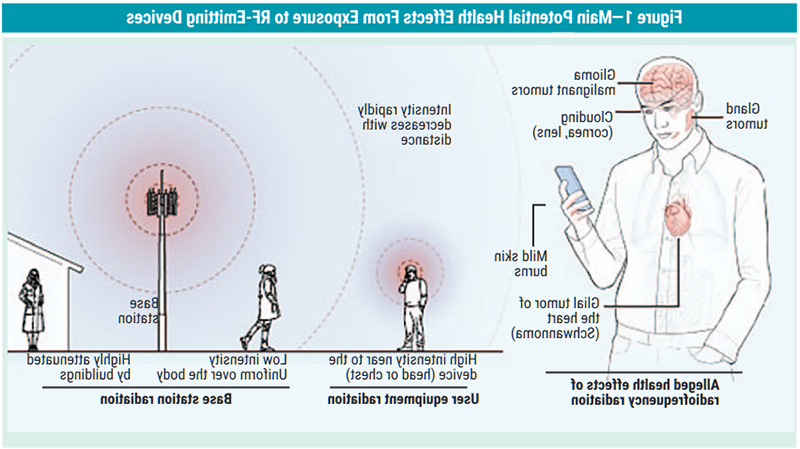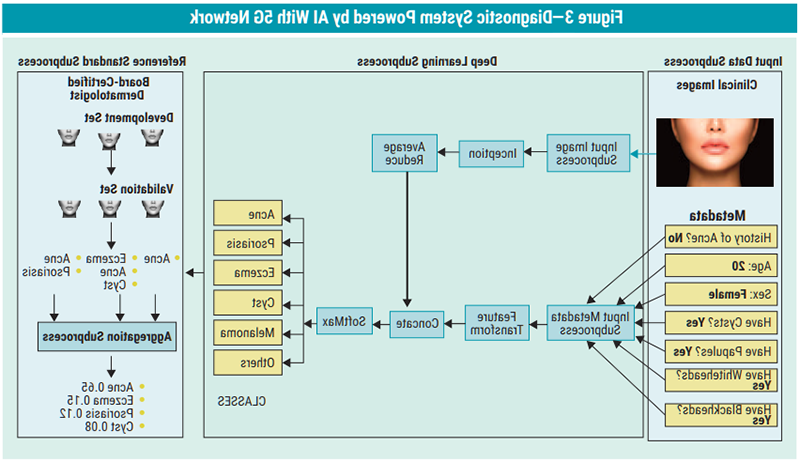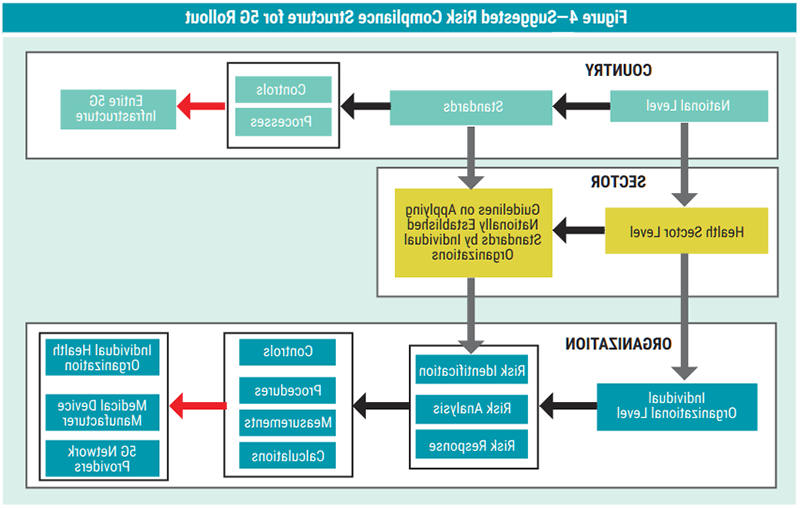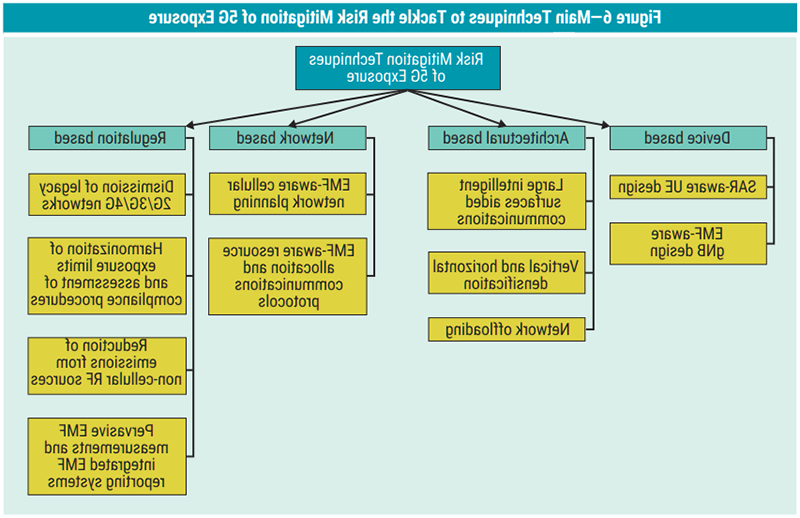In 2017, more than 180 scientists and doctors across the European Union (EU) co-signed an appeal calling on the EU to halt the rollout of fifth generation (5G) technology for telecommunications until potential hazards for human health and the environment could be fully investigated by scientists independent of the industry. The scientists and doctors claimed that 5G could substantially increase exposure to radiofrequency electromagnetic fields (RF-EMF) on top of 2G, 3G, 4G and Wi-Fi for telecommunications already in place. RF-EMF has already been proven to be harmful for humans and the environment.1 In 2015, 190 scientists, doctors and engineers from approximately 40 countries sent an appeal to the United Nations, urging the World Health Organization (WHO) to reconsider the international guidelines for human exposure to the type of radiation emitted by wireless technologies.2
The other school of thought emphasized that the powerful waves of 5G technology were propelling another healthcare revolution. The worldwide general manager of health and life sciences at Intel stated that the 5G technology was going to create a monumental shift that would transform how one understood health, healthcare delivery, and access to care and experts.3
According to Deloitte, by 2040, healthcare, as it is known today, will no longer exist and there will be a fundamental shift from healthcare to health. Although diseases will never be eliminated completely, they will be identified earlier, and intervention will be proactive with better understanding of disease progression to assist patients more effectively, sustaining their well-being.4
To better understand 5G as it relates to health, it is necessary to focus on the negative and positive effects of 5G and the management of 5G risk as it is used to tackle the negative effects of 5G so that the positive effects can be achieved. The use of a framework to analyze, quantify and manage the associated 5G risk, such as the ISACA® Risk IT Framework is suggested.
5G Technology Overview
5G is the latest wireless mobile phone technology that is expected to increase mobile device performance, provide a wide range of new applications and strengthen different industries, including healthcare.5
As with previous cellular technologies, 5G networks depend on signals that generate RF emissions (or waves) through the 5G network and across 5G cell phones and other devices.
However, 5G networks use higher frequencies than previous mobile networks, thereby allowing more devices to have access to the Internet at the same time and at a faster speed. To achieve wider coverage, the radio waves from the 5G networks require more transmitter masts positioned close to ground level than those of previous technologies.6
The rolling out of the 5G cellular networks is a fundamental step to enable services offered by 5G across the world and involves installing new 5G base stations across communities and the diffusion of 5G user equipment among the users.7
5G Radio Frequency (RF) Emissions
There are two types of RF emissions generated by 5G technology:
- Ionizing radiation—These include radio waves that have enough energy to remove electrons from atoms in living human cells. When human cells are exposed to ionizing radiation, they either die or become cancerous.
- Non-ionizing radiation—These are made up of radio waves that do not have enough energy to ionize human cells, thus avoiding cancer and death for the exposed cells. However, the radio waves may have enough energy to vibrate the molecules, which can potentially cause health issues.
The possible health risks include:
- Rare forms of cancer (e.g., malignant tumors in the brain, glial tumors of the heart, parotid gland tumors)
- Mild skin burns
- Ocular effects (e.g., cataracts, retina damage, corneal issues)
- Male infertility
- Electromagnetic hypersensitivity (e.g., headaches, fatigue, stress, burning sensations, rashes)8
Human exposure to these two types of RF emissions will have negative health effects on humans (figure 1). Therefore, it is necessary to reduce these emissions to a level that will not penetrate human skin. Based on one study, the skin acts as a barrier, shielding internal organs, including the brain, from exposure to RF emissions.9

Source: King Abdullah University of Science and Technology/Xavier Pita. Reprinted with permission.
Despite the potential health risk factors, there are many benefits associated with the adoption of 5G technology for healthcare institutions. As shown in figure 2, 5G technology can provide a foundation for an entire Internet of things (IoT) ecosystem with the capability to unleash the full potential of this ecosystem. IoT systems, which make up the IoT ecosystem, link highly specialized devices designed for specific purposes but have a limited degree of programmability and customizability. These devices store and process data in a distributed manner.10 These devices also continuously gather data in real time over particular periods of time.11

The IoT systems residing on 5G networks can create opportunities to transform existing healthcare processes, thereby enabling a healthcare revolution. This healthcare transformation will save time and costs in administering healthcare services and can potentially save more lives.
Currently, 4G and prior networks form the underlying fabric for the current IoT ecosystem. However, 4G and prior networks are inadequate for handling the data load from the ever-increasing number of sensors and connected devices that make up the existing IoT systems. The inability to handle the data load limits what IoT can truly achieve.
5G technology provides vast improvements over the current capabilities of 4G and previous networks in the following ways:
- 5G technology provides a faster network with higher capacity that can serve the connectivity needs of the IoT ecosystem, thereby eliminating lags in transmitting data across the network.12 5G’s extremely fast speeds provide latency of merely one millisecond, which implies that one can download a high-definition (HD) film in seconds, compared to the longer time it takes to download a film via devices currently running on the 4G network.13
- 5G technology’s flexibility can support a massive number of static and mobile IoT devices that have diverse ranges of speed, bandwidth and quality of service requirements.14
- 5G technology can result in a 90 percent reduction in network energy usage with up to 10 years of battery life for low-powered IoT devices.
These improvements make the 5G platform a powerful enabler of IoT.15
Healthcare opportunities provided by an IoT ecosystem residing on a 5G network platform include:
- Expanding telemedicine—This enables patients to have appointments with their doctors via real-time, high-quality video conferencing, thereby improving access to and quality of healthcare.
- Transmission of large image files and data analysis—Currently, hospital networks sometimes stall, meaning patients must wait longer for treatment, which leads to providers seeing fewer patients than expected. With 5G technology’s capacity to enable faster transfer of huge medical images and other data in a secured manner and at exceptional network performance, healthcare delivery can be greatly improved. In addition, 5G technology allows for predictive analytics and prescriptive analysis in determining diagnoses and deciding treatment plans for patients.
- Artificial intelligence (AI) diagnostic systems—As shown in figure 3, these systems are powered by AI and, therefore, are capable of remotely identifying diseases. These are cyberphysical systems that have hardware and software components controlled by computer-based algorithms that provide the capability to link to, sense, compute and control the physical world.16 5G technology allows rapid transmission and processing of vast amounts of data collected via these systems over reliable, high-bandwidth networks. Therefore, these systems perform required tasks that are typically done by humans, but in less time and at a fraction of the cost. In addition, this type of system can also be used in discovering links between genetic codes.17
- Mobile robotic surgery systems—These are systems powered by 5G technology that drive surgery-assisting robots, therefore paving the way for robotic surgery whereby a surgeon in one location can perform surgical procedures remotely.
- Decentralizing the healthcare model—Healthcare IoT systems residing on the 5G network can promote the healthcare industry trend toward bringing healthcare closer to patients and outside of the hospital setting through urgent care centers, walk-in clinics, outpatient surgery centers and home healthcare settings. Decentralizing healthcare can assist in lowering the rising costs of healthcare, protecting consumers’ interests, and making operations more reliable and accessible.18

Emission Standards to Mitigate Health Risk Due to RF Exposure
To take advantage of the opportunities provided by 5G technology and protect their citizens’ health, it is important that national advisory and regulatory bodies establish RF emission standards for a 5G network rollout in their countries. To assist in achieving the appropriate RF emission limits, national regulatory bodies can adopt and implement standards on RF exposure defined by international organizations, such as the International Commission on Non-Ionizing Radiation Protection (ICNIRP), Institute of Electrical and Electronics Engineers (IEEE), and the US Federal Communications Commission (FCC).
These standards consist of two distinct sets of limits for human exposure: general public limits and occupational limits. General public limits should be tailored to the public who are not aware of being exposed to radiation. Occupational limits are defined for workers subject to RF exposure in a controlled environment and, therefore, can take precautionary measures to reduce the exposure.
These standards are grouped into three types:
- Exposure standards—These are basic standards for personal protection that refer to the maximum levels to which whole or partial body exposure is permitted from any RF-emitting device.
- Emission standards—These are standards that set various specifications for devices in such a way that the total exposure to a device’s emissions does not exceed the exposure limits.
- Measurement standards—These are standards that show how compliance to exposure or emission standards are ensured.
These three types of standards are further classified into two categories:
- Voluntary instruments, which include guidelines, instructions and recommendations that are not legally mandated and, therefore, have no legal force
- Mandatory instruments, which include laws, acts, regulations and ordinances, and do require a legislative framework19
As shown in figure 4, these standards are established on the national level and drill down through business sectors (i.e., healthcare sector) to the individual organization level, where they are applied to the underlying 5G platform provided by the 5G network providers, the IoT systems that reside on the platform and are owned by the healthcare organizations, and the individual 5G devices that are components of the IoT systems manufactured by medical device manufacturing companies.

On the sector level, health sector agencies serve as the bridge between the national advisory and/or regulatory bodies and the individual organizations by providing the interpretation and application guidelines of these standards.
Based on these interpretations and guidelines, individual healthcare organizations can identify risk and implement controls and techniques, which include measurements and calculations, to mitigate the risk in order to ensure that the organizations maintain acceptable emission levels generated by their networks and devices.
Individual organizations can effectively manage the risk of noncompliance by implementing a framework such as ISACA’s Risk IT Framework.20 The Risk IT Framework sets good practices by providing a framework for organizations to identify, govern and manage IT risk.
The Risk IT Framework enables an organization to establish its unique risk appetite; that is, the amount of risk an organization is prepared to accept. Risk appetite varies among organizations, such as:
- Enterprises that want to achieve their objectives using 5G technology
- Enterprises that produce 5G devices for IoT systems and may incur losses
- Enterprises that are predisposed to risk taking, ranging from cautious to aggressive
In addition, the Risk IT Framework enables an organization to establish its risk tolerance, which is the tolerable deviation from the level set by the risk appetite and the organization’s healthcare objectives, and to provide risk awareness within the organization. Risk awareness helps IT risk to be well understood, known and managed by the enterprise.21
As shown in figure 5, the Risk IT Framework provides the organization with responses to identified key risk areas. After completing the risk analysis, the organization then establishes a risk response, which manages the future residual risk in line with the organization’s defined risk tolerance limits. Defining risk responses is often dependent on the organization’s budget limits.

Source: ISACA®, Risk IT Framework, 2nd Edition, USA, 2020, http://store.1acart.com/s/store#/store/browse/detail/a2S4w000004Ko9VEAS
Techniques Implemented to Reduce RF Emission Levels
As shown in figure 6, some of the possible techniques that can be implemented to reduce RF emission levels by healthcare organizations, medical device manufacturers, or 5G network providers to thereby mitigate or reduce health risk resulting from RF exposure include the following:
- Device-based solutions, which focus on reducing RF exposure at the level of individual devices
- Architectural-based designs that introduce new architectural features in and beyond 5G networks, which can improve service level and reduce the RF exposure levels over a territory (figure 7)
- Network-based solutions aimed at developing RF-aware solutions that manage radio resources and communication protocols to reduce RF exposure
- Regulation-based approaches that target adopting regulations around RF emissions, which will ensure risk reduction by:
- Eliminating legacy 2G/3G/4G networks
- Making all exposure limits comparable or the same
- Creating compliance assessment procedures across countries
- Defining constraints to limit the emissions from non-cellular RF sources

Source: King Abdullah University of Science and Technology/Xavier Pita. Reprinted with permission.

Source: King Abdullah University of Science and Technology/Xavier Pita. Reprinted with permission.
Through this approach, the healthcare industry can install 5G networks while ensuring RF exposure is limited.22
Conclusion
5G technology provides opportunities to positively transform and improve current healthcare systems around the world. However, this technology also comes with uncertainties and possible health risk that could lead to a human health catastrophe. More research is needed to identify and confirm potential health risk.
Therefore, to explore these opportunities, it is important that healthcare organizations, medical device manufacturers and 5G network providers collectively mitigate potential risk by ensuring that they individually reduce the RF exposure of both patients, providers and the general public from the use of the healthcare IoT systems, 5G devices that are components of these IoT systems and from the underlying infrastructure that constitutes the 5G platform. The identified risk areas can be analyzed, quantified and appropriately responded to by implementing a framework such as the Risk IT Framework.
Endnotes
1 Nyberg, R., L. Hardell; “The Appeal,” 5G Appeal, September 2017, www.5gappeal.eu/scientists-and-doctors-warn-of-potential-serious-health-effects-of-5g/
2 Tiffany, K.; "Something in the Air," The Atlantic, 13 May 2020, http://www.theatlantic.com/technology/archive/2020/05/great-5g-conspiracy/611317/
3 Vox Creative, “Why 5G Is Poised to Change Healthcare,” 12 November 2018, http://www.recode.net/ad/18088220/5g-healthcare-revolution
4 Deloitte, “The Future of Health,” United Kingdom, http://www2.deloitte.com/us/en/pages/life-sciences-and-health-care/articles/future-of-health.html
5 World Health Organization (WHO), “5G Mobile Networks and Health,” Switzerland, 27 February 2020, http://www.who.int/news-room/q-a-detail/5g-mobile-networks-and-health
6 BBC News, “Does 5G Pose Health Risks?” 14 July 2019, http://www.bbc.com/news/world-europe-48616174
7 Chiaraviglio, L.; A. Elzanaty; M. S. Alouini; "Health Risks Associated With 5G Exposure: A View From the Communications Engineering Perspective," June 2020
8 Ibid.
9 Broad, W. J.; "The 5G Health Hazard That Isn't," The New York Times,16 July 2019, http://www.nytimes.com/2019/07/16/science/5g-cellphones-wireless-cancer.html
10 Yoo, C. S.; "The Emerging Internet of Things,” CIGI, 2 April 2019, http://www.cigionline.org/articles/emerging-internet-things
11 Sequeira, N.; "What 5G Means for the Future of Internet of Things," 5G Technology World, 11 January 2019, http://www.5gtechnologyworld.com/what-5g-means-for-the-future-of-internet-of-things
12 Verizon, “5G and IoT: The Future of 5G Communications,” 4 March 2020, http://www.verizon.com/about/our-company/5g/iot-future-5g-communications
13 Op cit Sequeira
14 GSMA, Internet of Things in the 5G Era: Opportunities and Benefits for Enterprises and Consumers, United Kingdom, November 2019, http://www.gsma.com/iot/wp-content/uploads/2019/11/201911-GSMA-IoT-Report-IoT-in-the-5G-Era.pdf
15 Op cit Sequeira
16 Carnegie Mellon University College of Engineering, “Cyberphysical Systems,” Pittsburgh, Pennsylvania, USA, http://engineering.cmu.edu/research/cyberphysical-systems.html
17 Woollaston, V.; "14 Ways 5G Will Transform Healthcare in the Wake of Coronavirus," 5Gradar, 22 July 2020, http://www.5gradar.com/features/ways-5g-will-transform-healthcare
18 AT&T Business, 5G & Healthcare, USA, 2019, http://www.business.att.com/content/dam/attbusiness/briefs/5g-healthcare-ebook-brief.pdf
19 World Health Organization (WHO), Framework for Developing Health-Based EMF Standards, Switzerland, 2006
20 ISACA®, The Risk IT Framework, 2nd Edition, USA, 2020, http://9fsw.1acart.com/resources/it-risk
21 Oyemade, R.; "Effective IT Governance Through the Three Lines of Defense, Risk IT and COBIT," ISACA® Journal, vol. 1, 2012, http://9fsw.1acart.com/resources/isaca-journal/issues
22 Op cit Chiaraviglio
Ronke Oyemade, CISA, CRISC, CISM, CDPSE, PMP
Has more than 20 years of consulting experience in industries such as oil and gas, healthcare, media, education, hospitality, data management, finance, telecommunications, media, retail, manufacturing, and insurance. Her areas of expertise include IT security, cybersecurity, IT compliance and US Sarbanes-Oxley Act of 2002 (SOX) compliance. She is a member of the Project Management Institute and can be reached at strategicglobalconsult@gmail.com.
